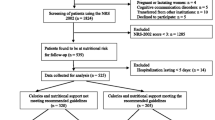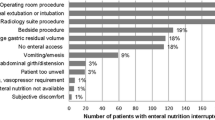Abstract
Objective
To observe the influences of branched-chain amino acids (BCAAs) on nutrition metabolism and prognosis of patients with severe abdominal trauma; at the same time, to analyze and evaluate the pharmacoeconomics of it.
Methods
A total of 75 severe abdominal trauma patients were recruited from June 2016 to December 2017 and randomly divided into control group and observation group. After surgery and basic treatment, parenteral nutrition support therapy with iso-nitrogen and iso-calorie of both groups was administered. Meanwhile, an equivalent of 8.5% (18AA-II) and 10% (20AA) compound AA injection was administrated to the control and observation groups, respectively. The nitrogen balance, serum protein level and plasma amino spectrum of the patients were observed before and after treatment. Besides, the hospital stay, survival rate, complications, adverse reactions and hospitalization costs were also compared.
Results
After a 7-day course treatment, the nitrogen balance level of the two groups was significantly improved, but no significant difference was found between them. In addition, the serum protein level and plasma amino spectrum of the two groups was generally improved when compared to before treatment. Compared with the control group, the level of albumin and transferrin in the observation group was improved significantly after treatment, while no difference in plasma amino spectrum was found between the two groups. Moreover, the cost analysis showed remarkably reduced hospitalization costs in the observation group.
Conclusion
To a certain degree, BCAAs could improve the nutritional metabolism and prognosis of patients with severe abdominal trauma, and have good cost-effectiveness.
Similar content being viewed by others
References
Rodríguez-García JA, Ponce-Escobedo AN, Pérez-Salazar DA, et al. Nutritional support in polytraumatized patients. Nutr Hosp (Spanish), 2005,20(2):47–50
Weissenfluh GM, Brundage SI, Spain DA. Early enteral nutrition after abdominal trauma: effects on septic morbidity and practicality. Nutr Clin Pract, 2006,21(5):479–484
McKibbin B, Cresci G, Hawkins M. Nutrition support for the patient with an open abdomen after major abdominal trauma. Nutrition, 2003,19(6):563–566
Yin J, Wang J, Zhang S, et al. Early versus delayed enteral feeding in patients with abdominal trauma: a retrospective cohort study. Eur J Trauma Emerg Surg, 2015,41(1):99–105
Monteleoni C, Elizabeth C. Using rapid-cycle quality improvement methodology to reduce feeding tubes in patients with advanced dementia: before and after study. BMJ, 2004,329(7464):491–494
Yoon MS. The Emerging Role of Branched-Chain Amino Acids in Insulin Resistance and Metabolism. Nutrients, 2016,8(7):405
Lu J, Xie G, Jia W, et al. Insulin resistance and the metabolism of branched-chain amino acids. Front Med, 2013,7(1):53–59
Ginguay A, De Bandt JP, Cynober L. Indications and contraindications for infusing specific amino acids (leucine, glutamine, arginine, citrulline, and taurine) in critical illness. Curr Opin Clin Nutr Metab Care, 2016,19(2):161–169
Fernstrom JD. Branched-chain amino acids and brain function. J Nutr, 2005,135(6):1539S–1546S
Platell C, Kong SE, McCauley R, et al. Branched-chain amino acids. J Gastroenterol Hepatol, 2000,15(7):706–717
Moura CS, Lollo PCB, Morato PN, et al. Modulatory effects of arginine, glutamine and branched-chain amino acids on heat shock proteins, immunity and antioxidant response in exercised rats. Food Funct, 2017,8(9):3228–3238
Tanaka H, Fukahori S, Baba S, et al. Branched-Chain Amino Acid-Rich Supplements Containing Microelements Have Antioxidant Effects on Nonalcoholic Steatohepatitis in Mice. JPEN J Parenter Enteral Nutr, 2016,40(4):519–528.
Bonvini A, Coqueiro AY, Tirapegui J, et al. Immunomodulatory role of branched-chain amino acids. Nutr Rev, 2018,76(11):840–856
Holecek M. Branched-chain amino acids in health and disease: metabolism, alterations in blood plasma, and as supplements. Nutr Metab (Lond), 2018,15(3):33
Chen L, Chen Y, Wang X, et al. Efficacy and safety of oral branched-chain amino acid supplementation in patients undergoing interventions for hepatocellular carcinoma: a meta-analysis. Nutr J, 2015,14(9):67
Bifari F, Nisoli E. Branched-chain amino acids differently modulate catabolic and anabolic states in mammals: a pharmacological point of view. Br J Pharmacol, 2017,174(11):1366–1377
Kauvar DS, Wade CE. The epidemiology and modern management of traumatic hemorrhage: US and international perspectives. Crit Care, 2005,9(5):S1–S9
Brenner M, Hicks C. Major Abdominal Trauma: Critical Decisions and New Frontiers in Management. Emerg Med Clin North Am, 2018,36(1):149–160
von Meyenfeldt MF, Soeters PB, Vente JP, et al. Effect of branched chain amino acid enrichment of total parenteral nutrition on nitrogen sparing and clinical outcome of sepsis and trauma: a prospective randomized double blind trial. Br J Surg, 1990,77(8):924–929
McClave SA, Taylor BE, Martindale RG, et al. Guidelines for the Provision and Assessment of Nutrition Support Therapy in the Adult Critically Ill Patient: Society of Critical Care Medicine (SCCM) and American Society for Parenteral and Enteral Nutrition (A.S.P.E.N.). JPEN J Parenter Enteral Nutr, 2016,40(2):159–211
Muscaritoli M, Krznaric Z, Singer P, et al. Effectiveness and efficacy of nutritional therapy: A systematic review following Cochrane methodology. Clin Nutr, 2017,36(4):939–957
Wolfe RR. Branched-chain amino acids and muscle protein synthesis in humans: myth or reality? J Int Soc Sports Nutr, 2017,14:30
Foure A, Bendahan D. Is Branched-Chain Amino Acids Supplementation an Efficient Nutritional Strategy to Alleviate Skeletal Muscle Damage? A Systematic Review. Nutrients, 2017,9(10):1047
Matthews DE. Observations of branched-chain amino acid administration in humans. J Nutr, 2005,135(6),1580S–1584S
Zanchi NE, Nicastro H, Lancha AH. Potential antiproteolytic effects of L-leucine: observations of in vitro and in vivo studies. Nutr Metab (Lond), 2008,5:20
Jimenez FJ, Ortiz LC, Morales MS, et al. Prospective study on the efficacy of branched-chain amino acids in septic patients. JPEN J Parenter Enteral Nutr, 1991,15(3):252–261
Choudry HA, Pan M, Karinch AM, et al. Branched-chain amino acid-enriched nutritional support in surgical and cancer patients. J Nutr, 2006,136(1):314S–318S
Oki JC, Cuddy PG. Branched-chain amino acid support of stressed patients. DICP, 1989,23(5):399–410
von Meyenfeldt MF, Soeters PB, Vente JP, et al. Effect of branched chain amino acid enrichment of total parenteral nutrition on nitrogen sparing and clinical outcome of sepsis and trauma: a prospective randomized double blind trial. Br J Surg, 1990,77(8):924–929
Bianchi G, Marzocchi R, Agostini F, et al. Update on branched-chain amino acid supplementation in liver diseases. Curr Opin Gastroenterol, 2005,21(2):197–200
Tajiri K, Shimizu Y. Branched-chain amino acids in liver diseases. World J Gastroenterol, 2013,19(43):7620–7629
Cerra FB, Mazuski JE, Chute E, et al. Branched chain metabolic support. A prospective, randomized, doubleblind trial in surgical stress. Ann Surg, 1984,199(3):286–291
Cerra FB, Shronts EP, Konstantinides NN, et al. Enteral feeding in sepsis: a prospective, randomized, doubleblind trial. Surgery, 1985,98(4):632–639
Author information
Authors and Affiliations
Corresponding author
Additional information
This study was supported by the Medical Research Program of Chongqing Health Commission (No. 2019MSXM086).
Rights and permissions
About this article
Cite this article
Xu, B., Wu, D., Xiang, Jx. et al. Effects of Branched-chain Amino Acids on Nutritional Metabolism and Pharmacoeconomics in Patients with Severe Abdominal Trauma. CURR MED SCI 41, 894–900 (2021). https://doi.org/10.1007/s11596-021-2424-0
Received:
Accepted:
Published:
Issue Date:
DOI: https://doi.org/10.1007/s11596-021-2424-0




